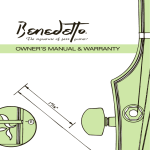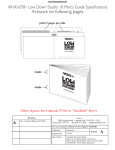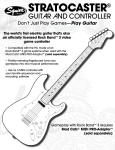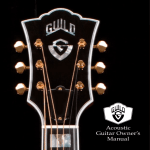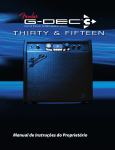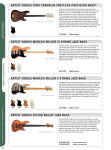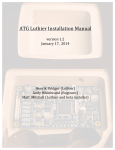Download OWNER`S MANUAL
Transcript
OWNER’S MANUAL FOR FENDER® BASSES Languages 1 Si necesita acceder a los manuales de instrucciones de las guitarras bajos en Español, visite nuestra página web http://www.fender.com/support Vous trouverez le mode d’emploi des guitares basses Fender® en français sur le site Internet http://www.fender.com/support Il manuale d’uso dei bassi Fender® in Italiano è disponibile nel nostro sito web http://www.fender.com/support Das Fender Bedienungshandbuch für Bässe in Deutsch, finden Sie auf unserer Website http:// www.fender.com/support Se desejar ler o manual do proprietário Fender® para baixos em português, por favor, visite nosso website em http://www.fender.com/support 日本語のベースギター用 Fender オーナーズ・マニュアルは、弊社のウェブサイト http://www.fender.com/support をご参照ください。 Welcome to the Fender® Family Congratulations, you’ve just purchased a piece of history from Fender Musical Instruments, the company that brought the solid body electric bass guitar to the world. Whether you are new to the bass or even if you’ve been playing for years, this manual will give you all the information you need to take the mystery out of tuning, changing strings, setup, adjustment, intonation, care, and maintenance of your bass. It’s easy! And once you’ve learned how to care for your bass properly, you’ll find that it will take great care of you too, by providing a wonderful vehicle for years of fun, creativity, and musical self-expression. With that in mind, we hope you’ll take a few moments to read through this entire owner’s manual. You’ll be glad you did! 2 History From the Beginning… Fender---our very name is synonymous with all things bass. The electric bass guitar and the bass amplifier simply weren’t available to the masses before Clarence “Leo” Fender and his small Southern California company conceived of and produced the Precision Bass® and the Bassman® amplifier in the early 1950s. Throughout the 1930s and ‘40s, the upright bass, which was the standard in popular music at the time, could barely be heard beneath the rumble and volume of the pop and big bands of the era. In 1951 Fender changed all of that with the creation of the Precision Bass®, an electric bass guitar with “precise” intonation that when amplified, could be easily heard and felt on the bandstands and throughout the dance venues of the day, forever altering the landscape of popular and recorded Music. 3 History In 1960 Fender created another revolutionary instrument, the Jazz Bass®. With its offset waist, two pickups and narrow neck, the Jazz Bass was sonically versatile, faster playing, and soon became the standard by which all other bass guitars were measured. Fender basses became the most recorded basses on the planet and they persist in dominating the catalogs of popular music today because the unique character of their voices has helped to define and shape the very styles and genres of electric music we all love and listen to. Fender continues to be on the cutting edge of bass guitar development and offers a phenomenal selection of world class basses and bass amplifiers for everyone from the beginning player to seasoned touring and recording professionals. From James Jamerson to Geddy Lee to Jaco Pastorius to Marcus Miller, the Fender bass has been the vehicle of choice for the masters and innovators. With your new bass, the same opportunity to become a virtuoso is now in your hands. So,… now that you have a brand new bass guitar, it’s time to strap it on, plug it in and Make History™! 4 History 1951 Precision Bass® and Bassman® amp created 1946 1954 Fender founded by Stratocaster® Clarence Leonidas unveiled “Leo” Fender 1950 Telecaster® and Esquire® created 5 1960 Jazz Bass® created 1965 Fender sold to CBS Timeline 2000+ Fender continues to innovate into the future 1958 mid-1980s Jazzmaster® quitar modern-era Fender created launched 1962 1952 ® quitar Jaguar The Twin Amp® created created 6 Anatomy 101 Anatomy 7 Whether you know the names of all the parts or not, anatomical charts are always cool. Here’s the basic anatomy of a bass guitar: body pickup pole pickups piece strap button bridge saddle neck bridge strap button intonation adjustment screw output jack volume/tone control knobs string pickguard truss rod adjustment (depending on model) truss rod adjustment (depending on model) dot position inlay fret tuning machines (keys) fingerboard Anatomy tuning machine post (shaft) 12th fret (octave) position inlay nut string tree (retainer) headstock 8 9 You can always contact us directly to get this information as well, either by mail, telephone or e-mail: Specs Controls & For switch/control function diagrams, parts lists and wiring diagrams for your specific model, visit the “Support” section of www.fender.com, where the “Wiring Diagrams/Parts Lists” link will take you to info several Fender instrument models. Attn: Consumer Relations Fender Musical Instruments Corp. 8860 East Chaparral Road, Suite 100 Scottsdale, Ariz. 85250-2610 480.596.7195 [email protected] 10 Info Features For detailed info on the features and specifications of your bass guitar, visit the “Products” section of www.fender.com, where each individual bass guitar listing has a “Specs” link that’ll give you an easy-to-read list. Info UNDERSTANDING THE EFFECTS OF TEMPERATURE AND HUMIDITY… Your bass has been constructed with the finest materials and processes available. As part of its final assembly, it has been hand adjusted and set up to the Fender® factory specifications, which produce the best possible playing action. However, this instrument, like all instruments made from wood, can be sensitive to fluctuations in temperature and humidity. The woods of your bass absorb moisture from the air when it is humid, and they evaporate moisture out when the humidity falls. The wood also expands and contracts with changes in temperature. These natural movements are fairly minute, and while generally not visible to the naked eye, they can dramatically affect the setup and playability of the instrument. On a hot day, for example, when an already-tuned instrument is taken from a hot car into a cool air-conditioned environment and removed from its case, its woods cool and shrink fairly quickly. This contraction decreases the string tension and causes the tuning to drop noticeably flat. These same aspects may come into play after an instrument leaves our factory and before you receive it from your Dealer. The playing action and setup of the instrument when you receive it will depend on several factors, such as: • • • • • • • 11 The amount of time between the final assembly and when the instrument actually ships from Fender. The amount of time taken during shipping for the instrument to travel from Fender’s warehouse to its final destination. The method of shipping the instrument, i.e. ground, air etc. The climatic conditions the instrument is exposed to during shipment. The climatic conditions of the shipping destination. The amount of time the instrument is in stock at your Fender Dealer before you receive it. Whether or not a product preparation setup has been performed on the instrument by your Dealer before you receive it. DO NOT BE ALARMED IF, WHEN YOU FIRST RECEIVE THE INSTRUMENT, YOU FIND THAT THE PLAYING ACTION IS NO LONGER SET TO FACTORY SPECIFICATIONS. IT IS NATURAL FOR THE SETUP TO CHANGE OVER TIME WHEN EXPOSED TO THE FACTORS DESCRIBED ON THE PREVIOUS PAGE. Fender electric instruments have numerous points of adjustment that will allow you to compensate for the changes in the playing action that may have occurred between final assembly and when you receive the instrument. If you find the action to be too high or too low for your taste or playing style, please review this manual for details on the setup, adjustment, and maintenance that will return the instrument to an optimum playing condition for you. Please Note: Initial standard setup and adjustment of the instrument and its components at the time of purchase are considered normal Dealer product preparation and are not covered by the Fender warranty. Upon receipt and acceptance of the instrument, the consumer assumes all responsibility for setups, adjustments, and maintenance. 12 Info If you have any doubts in your ability to make these adjustments correctly, take your bass to an Authorized Fender Service Center for assistance. Great Electric Bass Guitar Setup While it is certainly possible to give your bass a great setup just using some basic tools and your eyeballs, we have found that the job is considerably easier with the right tools. For best results in changing strings and performing setups and adjustments, we recommend using the tools listed below. Set-up • Electronic tuner • Wire cutters • Capo • Set of automotive feeler gauges (.002” - .025”) • A 6” ruler (with 1/32” and 1/64” increments) • A large Phillips screwdriver (Vintage Series basses), or the hex truss rod adjustment wrench that accompanied your bass (modern basses) • Mini flat-head screwdriver (Vintage Series basses), or the hex saddle height adjustment wrench that accompanied your bass (modern basses) TUNING If you don’t own an electronic tuner, you may want to purchase one. It will simplify many of the following procedures. If you already have one, just plug in and turn the bass’s volume control all the way up. Pluck either an open string or the 12th fret harmonic*, to produce the clearest tone for the tuner. (*A harmonic is a “chime-like” tone that is produced by lightly touching the exact mid point of the string at the twelfth fret with your finger tip, and plucking the string with the other hand.) Note: If you press the string too hard, it will choke the string and mute the sound. With a little practice though, you’ll develop the light touch needed to make the harmonic ring out. 13 If you’re playing a 4-string bass, tune the open strings to E, A, D, G E A D G If you’re playing a 5-string bass, tune the open strings to B, E, A, D, G E A D G Set-up B If you’re playing a 6-string bass, tune the open strings to B, E, A, D, G, C B E A D G C 14 Set-up Changing Strings A fresh set of strings can breathe new life into your bass, and something as simple as how you wind the strings onto the tuning machine posts when changing your strings, will determine tuning stability and string tension. It’s also a good idea to stretch your strings a little as you tune to make sure that each string is seated well and snugged down on the tuning machine post. This will save you some tuning frustration down the road. Just grab the string in the middle, lightly tug it up and down to remove slack, and then retune. (See your Fender® Dealer to obtain replacement Fender bass strings.) First start by pulling each string through the bridge, over the nut and past the corresponding tuning machine post, with enough extra length to allow a minimum of three winds around it. Mark that point on the string. With wire cutters, crimp the string over at a 45-degree angle one inch before the mark, then clip off the excess at the mark, (Figure A). Next, place the end of the string all the way down in the hole in the center of the tuning machine post and bend the string over in the slot. Wind the tuning key to tighten the string to pitch while holding the loose end of the string in place with your other hand, (Figure B). Make sure that the string does not overlap itself and is wound from the top down to the base of the tuning machine shaft, to insure the string is seated properly on the nut with the most acute break angle possible, (Figure C). 15 Figure B Figure A Figure C Changing Batteries Fender produces basses with passive electronics (no batteries) and basses with active (battery-powered) preamps. Some active basses have an active/ passive switch, to switch between modes. Depending on the instrument, your active bass may have either a 9-volt (one-battery) system, or an 18-volt (twobattery) system. (Visit the Fender website for detailed specifications for your instrument.) As your batteries lose their power, the voltage supplied to the preamp will also drop, which will result in distortion and noise in the bass’s signal. When distortion and noise occur in your signal, it is your cue that the batteries must be changed for the instrument to operate correctly. Note: Active basses that do not have an active/passive switch will not play passively when the batteries are dead. For basses with 2-battery 18-volt preamps, always replace both batteries at the same time, as mismatched voltages may adversely affect the performance of the preamp. It is a good idea to use the same brand of battery consistently, over the life of the instrument. Weather, specifically temperature and humidity, may have a dramatic impact on the way your bass plays. All instrument woods expand and contract with seasonal fluctuations in temperature and humidity, and naturally, string height and playing action are affected. Depending on the climate where you live, your bass may need routine adjustments a couple of times a year. Fender® basses have several points of adjustment which are there to compensate for the adverse effects of these environmental changes, and more importantly, these features allow you to tailor the playing action of the bass to your own personal playing style. Note: The following factory specifications are median specs, and are meant only to guide you. They should not be taken as hard and fast rules. If you prefer your action a little higher or lower, change it as you like, but be aware that higher action will be more difficult to play and lower action may result in excessive fret buzz, depending on your technique, or style of play. 16 Set-up Typical battery life for both systems is approximately 600 hours of playing time. All Fender basses with active preamps are equipped with switching jacks which engage the battery when a cable is plugged into the jack. Note: To maximize battery life, unplug your cable from the bass when not playing the instrument. Setup and Adjustment Made Easy The following setup procedures and specifications are for your Fender bass as equipped with the strings that come on the instrument as standard equipment from the factory. If you plan to change string gauges, you may need to adjust the specs somewhat to compensate for the changes in string sizes. Modifications of the specs may also be made (within limited parameters) to adjust for your individual playing style or application (i.e., how hard you pick, finger, slap, pop or fret the bass). Truss Rod Adjustment Set-up String tension exerts a tremendous bending force on the neck of the bass. The adjustable steel truss rod in the neck exerts a counter-force to the pull of the strings. If these two opposing forces are not in harmony with each other, the result will be a poorly playing instrument. Note: A truss rod that is too loose will result in a concave neck bow and high action, which will require more effort to play, (Figure D). A truss rod that is too tight will result in a convex neck bow, excessively low action and buzzing strings, (Figure E) Figure D Figure E An ideally adjusted neck will have a moderate amount of relief (curvature), to accommodate the amplitude of the vibration of each string. The factory specification for appropriate neck relief for Fender® bass guitars is between .012” and .014”, measured between the bottom of the string and the top of the fret, at the 7th fret. To determine if your bass needs a truss rod adjustment, you must first measure the current relief in the neck. Before beginning, make sure the bass is tuned to proper pitch to facilitate an accurate measurement. Next, install a capo at the 1st fret (nearest to the headstock). If you are adjusting a 17 4-string bass, depress the “E” string at the last fret with one hand. (If you are adjusting a 5 or 6-string bass, depress the “B” string at the last fret.) With the feeler gauge in your other hand, check the gap between the bottom of the string and the top of the 7th fret and make note of the gap, (Figure F). The gap should be between .012” and .014”. If you don’t have feeler gauges don’t give up. You can approximate the appropriate gap by stacking a plain sheet of paper on top of a regular business card. If you find your truss rod needs adjustment, detune the strings first, to relieve neck tension before making the adjustment, and remember to retune to pitch before measuring again. To adjust the truss rod, use either a large phillips or flathead screwdriver (for most vintage style basses), or the hex wrench supplied with your bass (for modern basses). Figure F If the neck is too concave, (Figure D), turn the truss rod nut clockwise, (Figure G). If the neck is too convex, (Figure E), turn the truss rod nut counter clock-wise, (Figure H). Check your tuning, then re-check the gap with the feeler gauge, Note: Adjust the truss rod in small increments of only 1/4 turn at a time and allow time for the wood to settle before measuring and adjusting again. If you meet excessive resistance, if your neck needs constant adjustment, or you’re just not comfortable making this adjustment yourself, take your bass to an authorized Fender Service Center. Figure G Figure H 18 Set-up Note: For vintage style basses with the truss rod adjustment at the heel of the neck, you must remove the strings and loosen the neck mounting screws and/or remove the pickguard to gain access to the truss rod adjustment nut. String Height (Action) Adjustment Set-up The factory specification for string height for Fender® bass guitars is 6/64” on both the bass and treble sides. Before beginning, make sure your bass is tuned to proper pitch to facilitate an accurate measurement. Then, using your ruler, measure the distance between the bottom of each string and the top of the 17th fret, (Figure I). Adjust the bridge saddles to height according to the the factory recommendation, then re-tune. Use a mini-standard screwdriver for vintage saddles, (Figure J). Use the supplied hex wrench for modern saddles, (Figure K). Don’t be afraid to experiment with the height a little bit, until it feels right to you. If you play with a light touch you can get away with lower action. If you play hard, you’ll need a little higher action to avoid fret buzz and rattles. Figure I Figure J 19 Figure K Shimming and Micro-Tilt™ Adjustment Shimming is a procedure used to adjust the pitch, or angle of the neck in relation to the body and may be accomplished with either the use of a shim or by performing a Micro-Tilt adjustment. The need to adjust the pitch may occur when the relative string height is high, but the action adjustment is already as low as the string height adjustment will allow. A shim or a Micro-Tilt adjustment will tilt the neck back, relative to the plane of the body, which allows an increased range of action adjustment. The Micro-Tilt adjustment is a feature on some Fender® basses, that performs the same function as shimming, by tightening a hex screw in the neck pocket of the body against a pressure plate installed in the bottom of the neck. The Micro-Tilt eliminates the need to remove the neck from the body to perform the adjustment. Figure L Figure M 20 Set-up For those basses with the Micro-Tilt adjustment and a 3-bolt neck plate, first loosen the two neck mounting screws at the top, 1/2 turn. Next, loosen the neck mounting screw nearest to the adjustment access hole on the neckplate by at least 4 full turns, (Figure L). Then, tighten the hex screw through the hole in the neck plate with a 1/8” hex wrench approximately 1/4 turn, (Figure M). Retighten the neck screws when the adjustment is complete. To shim the neck, you must first remove the strings. Next, remove the four screws that hold the neck in place then separate the neck from the body, (Figure N). Note: All finishes remain somewhat elastic. Use care in separating the neck from the body as damage to the finish may occur if the neck finish has adhered to the body finish. Inadvertent damage caused to an instrument during set-up or adjustment is the responsibility of the consumer and will not be covered under the Fender® warranty. Set-up Place a shim approximately 1/4” wide x 1 3/4” long x .010” thick, (the thickness of a standard business card) at the end of the neck pocket, (Figure O), and re-attach the neck. Placing the shim in the neck pocket will effectively lower the string action, and allow approximately 1/32” of additional saddle height travel. Note: If you feel you need to make a pitch adjustment and you’re not comfortable with the procedure, take your bass to an authorized Fender Service Center. 21 Figure N Figure O Pickup Height Adjustment Properly adjusted pickups will ensure that your bass is performing to the best of its capability. On the other hand, improper pickup height can be the source of a couple of potentially confusing problems. Pickups set too low will appear to have a loss of output. Pickups set too high can cause excessive magnetic string pull, which may result in pitch warbling or false sharp readings when intonating your instrument. The pickups on your new bass are height adjustable for locating them in the appropriate relative position to the strings for optimum performance. To measure pickup height, depress each of the outside strings at the last fret. Using your ruler, measure the distances from the bottom of the strings to the top of the corresponding pole pieces on the pickups, (Figure P). For pickups without pole pieces, or those having flush mounted pole pieces, measure to the pickup surface. Use the Pickup Height Adjustment Chart as a starting point. Figure P Figure Q 22 Set-up The actual height you adjust to may vary, depending on the amount of magnetic pull of the pickup and the type of strings you are using. Heavier gauges of strings generally produce a higher amplitude of vibration and may require a bit more clearance. Adjust pickup height with a small Phillips screwdriver, (Figure Q). Note: When adjusting a pickup higher, it may be necessary to physically pull the pickup up into its raised position, as the foam spacer under the pickup typically compresses over time and will need the lift to help it expand and fill the void. Set-up Pickup Height Adjustment Chart Pickup Type Bass Side Treble Side Vintage Style Precision Bass® 8/64” 6/64” Vintage Style Jazz Bass® 8/64” 6/64” Standard Jazz Bass 7/64” 5/64” Standard Precision Bass 7/64” 5/64” American Standard Jazz Bass 7/64” 5/64” American Standard Precision Bass 7/64” 5/64” Vintage Noiseless™ Jazz Bass 8/64” 6/64” N3 Noiseless Jazz Bass 8/64” 6/64” Special Design Humbucking 7/64” 5/64” 23 Intonation Adjustment Note: Adjust the intonation only after completing all of the “Setup” steps on the previous pages. To intonate the bass we either shorten or lengthen the active vibrating length of each string so that it will be in tune with itself, relative to the scale length of the instrument. Intonation may be affected by climatic conditions, changes in neck relief, dirty, worn strings and even the process of putting on brand new strings, so it’s a good idea to make checking and adjusting intonation a regular part of your maintenance routine. Modern Bridge Figure R Set-up To set the intonation for your bass you will need an electronic tuner and either a small Phillips or standard screwdriver or hex wrench, (depending on whether the saddle length adjustment screws on your bridge are either Phillips, standard or hex). Note: A bass that has not been properly intonated will not play in tune, up and down the neck, even if you have tuned each string to accurate pitch with an electronic tuner. Vintage Style Bridge Figure S 24 The procedure for setting your intonation is as follows: 1. Plug into your tuner and turn the volume full up on the bass. Strike the harmonic, (see Tuning, page 13), at the 12th fret,and tune the string to the appropriate pitch. 2. Lightly press the string to the 12th fret, and recheck the pitch on the tuner. (If you press too heavily it will result in a false sharp reading.) 3. If the pitch of the harmonic and the pitch of the fretted note agree, then the string is properly intonated, and no adjustment will be necessary. If the two pitches disagree, you’ll need to make on of the following adjustments, using either a Phillips screwdriver or a hex wrench, depending on your specific bridge. Set-up 4. If the fretted note is sharper (higher in pitch relative to the harmonic), you will need to lengthen the active vibrating length of the string until the two pitches agree. To do this, turn the saddle length adjustment screw clockwise, moving the saddle toward the back of the bridge, until the harmonic and the fretted note register as the same pitch, (Figure R). It’s a good idea to stretch and re-tune the string during the adjustment, as the movement of the saddle will affect the pitch. 5. If the fretted note is flatter, (lower in pitch relative to the harmonic), you will need to shorten the active vibrating length of the string until the pitches agree. To do this, turn the saddle length adjustment screw counter-clockwise, moving the saddle forward, until the harmonic and the fretted note register as the same pitch, (Figure S). Remember to stretch and re-tune the string. Note: You may need to de-tune slightly and manually push the saddle forward to complete the adjustment, as the downward pressure from the string may not allow the saddle to move forward freely. 6. 25 When these procedures have been completed on each string, your bass should be properly intonated. Perform a final tuning check and there’s only one thing left to do. Just plug into your amp and Make History™! CARE AND MAINTENANCE Your new Fender® bass is precision crafted to give you many years of playing satisfaction. A few simple maintenance procedures will help keep your instrument in top condition for years to come. Keep Your Bass Clean: Dirt, dust, skin oils, perspiration and smoke can prematurely age the finish and fittings of your bass. Wipe down the entire instrument with a soft dry Fender approved polish cloth after each use. Clean and polish your bass periodically using a Fender approved polish on the finished wood surfaces and Fender approved polish/cleaner on the metal surfaces, then dry with a soft polishing cloth. Visit www.fender.com for information on Fender approved polish and polishing cloths. Oil The Fretboard Periodically: The natural oils in Rosewood, Pau Ferro and Ebony fingerboards may dry out over time. Rough, exposed fret edges are evidence of dry, shrunken wood. It is a good idea to give your fretboard a “drink” of lemon oil, boiled linseed oil or other non silicone-based wood/furniture oil, periodically to preserve its integrity and natural beauty. Note: With the strings removed, apply oil first to a clean lint free cloth, rub into the wood, let it soak in for a few minutes, and then wipe to dry any excess oil. Do not apply oil to the finished surfaces of the bass. Examine Strap Buttons Periodically: Over time, the shifting weight of your bass on the strap may cause the strap button screws to loosen up. Snug them up from time to time. If loose screws are neglected and not tightened up, the moving weight of the instrument may expand the mounting holes to the point where the screws will no longer hold fast. Setup And Adjust As Needed: Familiarize yourself with the setup and adjustment procedures in this manual or visit an Authorized Fender Service Center and adjust as needed. Note: Neglecting an instrument that is in need of adjustment may lead to complications. 26 Care Seasonal Adjustments: Your bass, like all instruments made from wood, can be sensitive to seasonal fluctuations of temperature and humidity. It is natural for the woods to expand and contract with these changes and this movement can affect the setup and playability of the bass. It’s a good idea to schedule routine adjustments to compensate for the effects of these seasonal variations. Care Avoid Exposing Your Bass To Climatic Extremes: Extremes in temperature and humidity may damage the instrument. If exposure is unavoidable, as during shipping, reduce string tension slightly to minimize potential damage. Allow a cold instrument to warm gradually before opening its case to avoid finish checking. Never leave your bass for any length of time, in an environment that you wouldn’t feel comfortable in yourself. Lacquer Finishes: Many Fender basses are finished with lacquer, a thin natural type of wood finish that has been used on fine handcrafted furniture and elite musical instruments for many years. Lacquer was the finish of choice for the most collectable and desirable vintage Fender instruments made in the ‘50s and ‘60s. Lacquer is a relatively thin and somewhat porous finish that allows the tone-woods to resonate much more freely, resulting in a more vibrant, and to many seasoned players, beautiful sounding instrument. While lacquer allows the instrument to vibrate generously, by its very nature, it is much more subject to the effects of wear, the aging of the underlying wood, chemical interactions and climatic conditions, than urethane or polyester finishes. If your bass is finished with lacquer, please make sure that you read the “Lacquer Finishes: Precautions and Care” card that accompanies your instrument. Avoid exposure of lacquer finishes to dyed fabrics or leathers, plastics, synthetics and surgical rubber tubing, (used on many guitar stands, hangers and straps), these materials will react adversely with the lacquer and mar the finish of the instrument. If you are unsure of what type of finish is used on your bass, please check the detailed specifications of your instrument at www.fender.com or call our Consumer Relations department at: 480-596-7195. Note: Checking, shrinkage, sinking, discoloration and rapid wear are all a natural part of the aging process of lacquer finishes, and as such, will not be covered under the Fender® warranty. 27 SERVICE: For service in the United States and Canada, please contact an Authorized Fender Service Center, which you can find by calling the Fender Consumer Relations Department (480.596.7195) or using the “Service Center Finder” link on the “Support” section of www.fender.com. For service outside the United States and Canada, please contact your authorized dealer or the Fender distributor in your country or region—there’s a helpful global “International Distributors” link on the “Resources” section of www.fender.com. Service 28 Warranty Fender Electric Instrument Limited Lifetime Warranty Fender Musical Instruments Corporation warrants this Fender brand instrument to be free from defects in materials and workmanship for as long as it is owned by the original retail purchaser, except that pickups, switches, jacks, controls, all other electronic components, tuning machines, hardware, pickguards, plated surfaces, gig bags, cases and case hardware are warranted for a period of one (1) year from the date of original purchase. This warranty applies only to the original retail purchaser when this instrument is purchased from an Authorized Fender Dealer and is subject to the limitations set forth herein. IMPORTANT: PLEASE RETAIN YOUR ORIGINAL SALES RECEIPT, AS IT IS YOUR PROOF OF PURCHASE VALIDATING THIS LIMITED WARRANTY. Fender has established a network of independent Authorized Fender Service Centers for warranty service. The Fender Dealer from whom you purchased your instrument may also be authorized for warranty service and should be the first point of contact when service of any kind is required for your Fender instrument. To receive warranty service, return the complete instrument to an Authorized Fender Service Center, with your sales receipt as proof of purchase, during the applicable warranty period. Defective components that qualify for coverage under this warranty will be repaired or replaced (at Fender’s discretion) without charge. Remedies beyond normal service repair of any Fender instrument require both an evaluation and confirmation of the defect and a direct recommendation to Fender from an Authorized Fender Service Center for alternative considerations. 29 All transportation, insurance and freight charges associated with warranty service and repairs on Fender instruments are the responsibility of the purchaser, as is any service initiated for the purpose of customizing setups or adjustments beyond factory specifications. Initial standard setup and adjustment of the instrument and its components at the time of purchase are considered normal Dealer product preparation and are not covered by this warranty. Limitations and exclusions The following items are not covered by this warranty. 1. Fret wear, saddle wear, nut wear, strings and batteries. 2. Checking, shrinking, sinking, discoloration and wear of lacquer finishes. 3. Setups, adjustments or routine maintenance of any kind. 30 Warranty 4. Damage to finishes or cracks, splitting, or warpage of wood due to changes in temperature or humidity, exposure to or contact with sun, fire, moisture, body salts and acids of perspiration, guitar straps, guitar stands/hangers made from vinyl, plastic, rubber or other synthetic materials, any other chemicals or non-Fender-approved polishes. 5. Damage, corrosion or rusting of any hardware components caused by humidity, salty air, or exposure to the moisture, body salts and acids of perspiration. Warranty 6. Any damage to an instrument resulting from customization or modification. 7. Normal wear and tear on any part of the instrument case or gig bag including jacks, controls, switches, plated surfaces, tuning machines, pickguards, zippers, clasps, handles, latches, case hardware, etc. 8. All other damage and deterioration due to normal usage, wear and tear, aging, accidents, neglect, abuse, or Acts of Nature. 9. Any instrument, whose serial number is missing, altered or tampered with in any fashion. 10. Any instrument purchased from anyone other than an Authorized Fender Dealer. 11. Instruments that have been serviced by unauthorized persons (any person other than a Fender Certified Technician at an Authorized Fender Service Center). THE FOREGOING CONSTITUTES THE ONLY WARRANTY MADE BY FENDER WITH RESPECT TO THE PRODUCTS AND IS MADE EXPRESSLY IN LIEU OF ALL OTHER WARRANTIES EXPRESS OR IMPLIED Any implied warranties, including without limitation, any implied warranties of merchantability or fitness for any particular purpose, imposed under state law are limited to the duration of this limited warranty. Some states do not allow limitations on how long an implied warranty lasts, so the above limitations may not be applicable to you. 31 FMIC ASSUMES NO LIABILITY FOR PROPERTY DAMAGE RESULTING FROM FAILURE OF THIS PRODUCT NOR ANY LOSS OF INCOME, SATISFACTION, OR DAMAGES ARISING FROM THE LOSS OF USE OF SAME DUE TO DEFECTS OR AVAILABILITY OF SAME DURING SERVICE. This warranty applies only to Fender instruments manufactured after January 1, 1998, and purchased and serviced within the U.S.A. and Canada. Warranties outside these countries are as defined by the authorized Fender Distributor for your country or region, and may vary from the above in terms and/or length. Fender Musical Instruments Corp. 8860 East Chaparral Road, Suite 100 Scottsdale, Ariz. 85250-2610 U.S.A. Phone: 480.596.9690 www.fender.com Fender®, Stratocaster®, Strat®, Telecaster®, Tele®, Precision Bass®, P Bass®, Jazz Bass®, J Bass® and the distinctive headstock designs commonly found on these guitars are registered trademarks of Fender Musical Instruments Corporation. All rights reserved. 32 Warranty IMPORTADO POR: Instrumentos Musicales Fender S.A. de C.V., Calle Huerta # 132, Col. Carlos Pacheco, C.P. 228890, Ensenada, Baja California, Mexico. RFC: IMF870506R5A Hecho en Mexico. Servicio de Cliente: 001-8665045875 NOTICE REGARDING USE OF HISTORIC PATENT NUMBERS/MARKINGS: FENDER is proud to offer some of the most iconic musical instruments and amplifiers of the past 60 years. Some FENDER products are intentional recreations or reissues of vintage guitars and amplifiers, and may therefore incorporate markings or text associated with original patents that have since expired. Specific examples of such models include patent numbers on the tremolo plates and decals of the JAGUAR® and JAZZMASTER® guitars, “Pat Pending” on some vintage TELECASTER® guitar bridge plates, and “Design and Circuits Patented” language on the control panels of certain model amplifiers in FENDER Vintage Modified, Vintage Reissue and Custom lines. Such markings are included only for the sake of historical accuracy, and are not intended to denote or imply live patents or ongoing patent protection. 33 34 © 2011 FENDER MUSICAL INSTRUMENTS CORP. P/N 0079381000 Rev. A










































